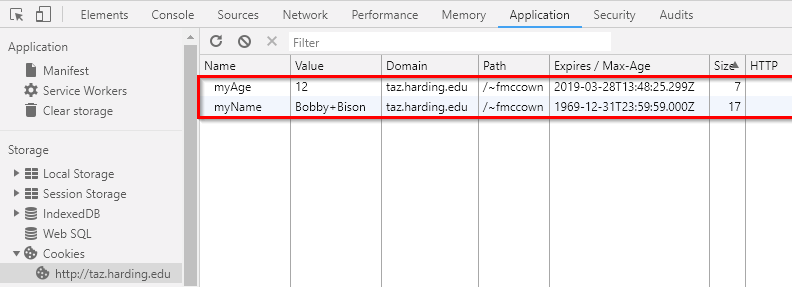- HTTP is a stateless protocol which means that each HTTP request/response is independent of previous or subsequent HTTP requests/responses
- However, it is often necessary for the web server to "remember" what happened in previous transactions (e.g., purchasing something online requires multiple web pages working in tandem)
- PHP uses two methods to keep state: cookies and session variables
- A cookie is a key/value pair that stores small pieces of data in the browser
- Frequently used by websites to track user behavior on a website or across different websites
- Browsers can block cookies, but most websites (especially web applications) rely heavily on cookies to work properly
- Each domain has its own cookies which cannot be shared with other domains (e.g., harding.edu cannot share with google.com)
- Cookies can be categorized based on when they expire
- Persistent cookie expires at a specific time (e.g., 5 days or 10 minutes)
- Session cookie expires when the session expires (the browser is closed)
- Transmission
- Unexpired cookies are transmitted in every HTTP request using the
Cookieheader - A server sets a cookie using the
Set-Cookieheader in the HTTP response
- Unexpired cookies are transmitted in every HTTP request using the
- Setting cookies
- Set with
setcookie(cookieName, cookieValue, [expirationDate])// Create "session cookie" which expires when browser is closed setcookie("myName", "Bobby Bison"); // Create "persistent cookie" which expires in 15 seconds setcookie("myAge", 21, time() + 15); - Examine Network traffic in Chrome and view Response Headers
Set-Cookie: myName=Bobby+Bison Set-Cookie: myAge=21; expires=Mon, 29-Oct-2018 22:32:06 GMT
- Set with
- Getting cookies
- Get from
$_COOKIES// Create session cookie which expires when browser is closed if (isset($_COOKIE["myName"])) echo "myName is $_COOKIE[myName]<br>"; if (isset($_COOKIE["myAge"])) echo "myAge is $_COOKIE[myAge]";
- Examine Network traffic in Chrome and view Request Headers
Cookie: myName=Bobby+Bison; myAge=21
- After 15 seconds have elapsed since setting the myAge cookie, the browser will no longer send it in the HTTP request
- Get from
-
Common mistakes
$_COOKIEScannot be used for setting cookies!// WRONG! Does not actually set any cookies on the browser $_COOKIE["myName"] = "Wild Bill";
-
Calling
setcookie()does not immediately put anything in$_COOKIESsetcookie("myName") = "Susan"; // ERROR! Not set until cookies are sent back from the browser! echo $_COOKIE["myName"];
- View and remove cookies in Chrome
- Open Developer's Tools (Ctrl-Shift-I)
- Click Application tab
- Expand Cookies and select the hostname storing the cookies

- A session variable is a key/value pair that are stored on the web server
- Session variables are better for storing sensitive data than cookies are because the data is stored on the server
- Session IDs
- A session ID is used to uniquely identify each user's session variables on
the server
// Displays user's session ID (Example: 556mkqe25ja90lnfsskij325t0) echo session_id();
- Session ID is stored in a session cookie (PHPSESSID) and sent to server
in every HTTP request

- Warning: Hacker could impersonate you by hijacking your session if they know your session ID
- A session ID is used to uniquely identify each user's session variables on
the server
- Setting session variables
- Always put
session_start()at top of script - Use $_SESSION to set value
// Creates a session ID if one doesn't already exist session_start(); $_SESSION["myName"] = "Bobby Bison"; $_SESSION["myAge"] = 21;
- Always put
- Getting session variables
- Always put
session_start()at top of script - Use $_SESSION to get value
// Creates a session ID if one doesn't already exist session_start(); if (isset($_SESSION["myName"])) echo "myName is $_SESSION[myName]<br>"; if (isset($_SESSION["myAge"])) echo "myAge is $_SESSION[myAge]";
- Always put
- Ending the session
- Use when there is no need for session variables (e.g., user logs out)
- Always put
session_start()at top of script - Use
session_destory()to remove all variables on the server// Creates a session ID if one doesn't already exist session_start(); // Clear all session variables session_destroy();